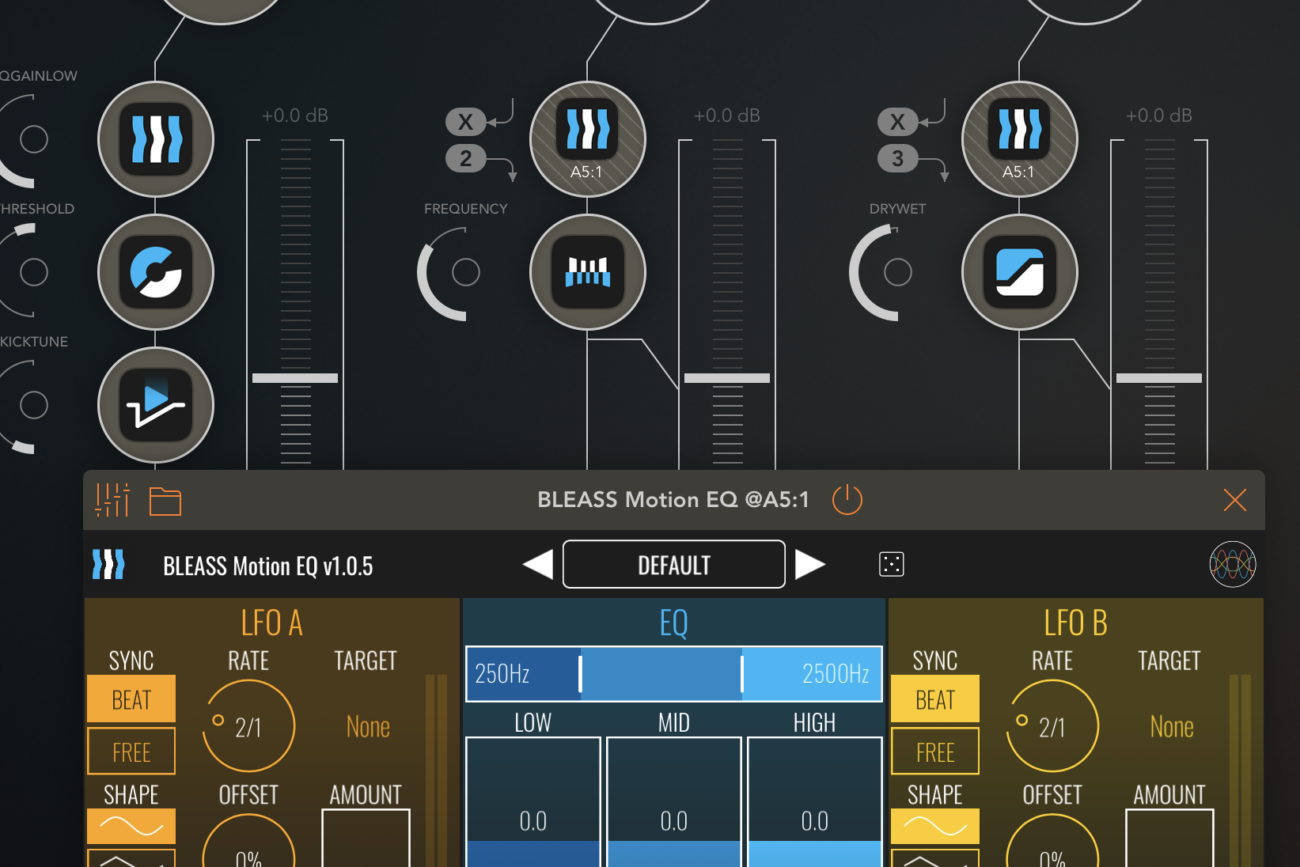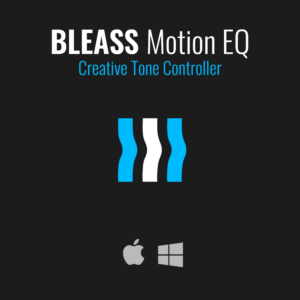
BLEASS Motion EQ is a powerful yet easy-to-use audio equalizer with unique features that unlock new realms of tonal creativity.
The plugin follows a graphic equalizer model, with the position of the three bands’ fader-style cut/boost controls also giving instant visual feedback of the EQ curve. But unlike a conventional graphic equalizer, BLEASS Motion EQ’s band widths are adjustable, making it easy to select the range of frequencies that will be affected by each band.
Not only does BLEASS Motion EQ let you balance the tone of your audio, it can also work as a flexible filter too. Low-pass, band-pass and high pass filtering can be achieved by making use of the band mute controls. You can even create an all-pass filter effect by moving the high and low cutoff frequencies close together.
The motion part of BLEASS Motion EQ comes in the form of a pair of LFOs (Low Frequency Oscillators). These can control the frequency cutoff point of each band, as well as the amount of cut or boost that each band applies, allowing you to create swirling, ever-shifting tonal patterns. And with the LFOs Synced to your DAW, all manner of rhythmic tonal pulses and movements are possible.
The creative possibilities are taken to a new level by BLEASS Motion EQ’s ability to send each band’s signal to its own output bus*. This makes the plugin operate like a crossover, allowing you to route each band to its own track for further processing and mixing.
LFO A / LFO B
Sync: Choose between a free-running LFO, or one that is synced to the beat of your host DAW.
Waveform: Select the shape of the LFO. From top to bottom: sine, triangle, saw-tooth up, saw-tooth down, square, and sample-and-hold.
Sync: When running in BEAT sync mode, sets the length of one LFO cycle in terms of beat-and-note length, from 32 bars down to 1/32 note (that is, a demisemiquaver). When running in FREE sync mode, sets the length of one LFO cycle in terms of cycles-per-second (Hz), from 0.03Hz to 10Hz.
Offset: When running in BEAT sync mode, offsets the LFO’s phase, or starting point.
Stereo: Creates a phase offset between left and right channels of the LFO signal. At ±100%, the channels are fully offset, with one channel hitting its maximum value when the other reaches its minimum. At 0% the two channels remain locked together.
Target: Selects the parameter that will be controlled by the LFO. As well as controlling the EQ’s parameters, LFO A can control LFO B’s parameters, and vice-versa.
Amount: Determines how strongly the LFO signal impacts on the targeted parameter.
Meter: The two-part bar meter provides an intuitive visualisation of how strongly each channel of the LFO is impacting on the targeted parameter.
EQ SECTION
Band Cutoff Frequencies: Sets the cutoff frequency for each band, thereby determining the range of frequencies that will be impacted by the band. Drag the left-hand vertical bar to control the upper limit of the low band and lower limit of the mid band; drag the right-hand vertical bar to control the upper limit of the mid band and lower limit of the high band.
Low / Mid / High: Sets the amount of cut or boost to apply to each band, from -60dB to +24dB.
Mute: Disables the band so that it is not heard. Muting two bands, leaving one unmuted, allows BLEASS Motion EQ to operate as a filter.
Output Bus: Directs the band’s signal to one of three output busses. Bus 1 feeds the track on which the plugin is inserted. Use your DAW’s routing options to direct busses 2 and 3 to other tracks within your project.
MULTIBUS OUTPUTS
BLEASS Motion EQ can route each band in a separate output bus:
On Desktop, Ableton, Bitwig & Pro Tools allow to route each band in a separate channel.
On iOS, AUM offers the ability to route each band via multibus outputs











